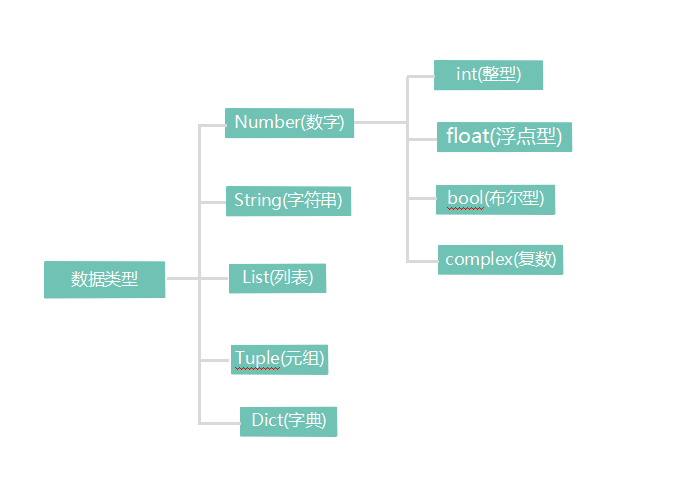1 变量
a 命名格式
var=value var1,var2,var3=value1,value2,value3 变量可以是任意数据类型,value是字符串时必须要用单引号('')或者双引号("")括起来
b 变量名(var)规则
1 变量名只能包含字母、数字和下划线,但不能有和数字开头 2 变量名不能包含空格,但可使用下划线来分隔其中的单词 3 不要将Python关键字和函数名用作变量名
2 数据类型

3 python3关键字
|
False |
None |
True |
|||
|
and |
as |
assert |
break |
class |
continue |
|
def |
del |
elif |
else |
except |
finally |
|
for |
from |
global |
if |
import |
in |
|
is |
lambda |
nonlocal |
not |
or |
pass |
|
raise |
return |
try |
while |
with |
yield |
4 python3内置函数
|
abs() |
dict() |
help() |
min() |
setattr() |
|
all() |
dir() |
hex() |
next() |
slice() |
|
any() |
divmod() |
id() |
object() |
sorted() |
|
ascii() |
enumerate() |
input() |
oct() |
staticmethod() |
|
bin() |
eval() |
int() |
open() |
str() |
|
bool() |
exec() |
isinstance() |
ord() |
sum() |
|
bytearray() |
filter() |
issubclass() |
pow() |
super() |
|
bytes() |
float() |
iter() |
print() |
tuple() |
|
callable() |
format() |
len() |
property() |
type() |
|
chr() |
frozenset() |
list() |
range() |
vars() |
|
classmethod() |
getattr() |
locals() |
repr() |
zip() |
|
compile() |
globals() |
map() |
reversed() |
__import__() |
|
complex() |
hasattr() |
max() |
round() |
|
|
delattr() |
hash() |
memoryview() |
set() |
常用内置函数描述
abs(num) 返回num的绝对值 all(iterable) 如果iterable的所有元素都为真或者 iterable为空,则返回Ture,否则返回False any(iterable) 如果iterable的任一元素都为真,则返回Ture,如果 iterable为空,则返回False divmod(num1,num2) 返回num1除以num2的商和余数 eval('num1+num2') 'num1+num2'字符串当做表达式计算,并返回计算的结果 float(num1) 将字符串或数值转化为浮点数 int(num1) 将字符串或数值转换为int isinstance(obj,cls) 检查obj是否是cls类的对象,是则返回Ture,否则返回False,也可以用来判断变量的类型
issubclass(class1,class2) 检查class1是否是class2的子类 len() 返回长度 max(num1,num2) 返回最大值 min(num1,num2) 返回最小值 pow(x,y) 返回x的y次方结果 dict([['key1','value1'],('key2','value2'),...]) 返回字典 list(iterable) 返回列表 tuple(iterable) 返回元组 map(function,iterable) 对iterable中的每个元素使用fuction函数,并将结果作为新的iterable返回 sum(iterable,num) 返回iterable所有元素加上num的和,num默认0